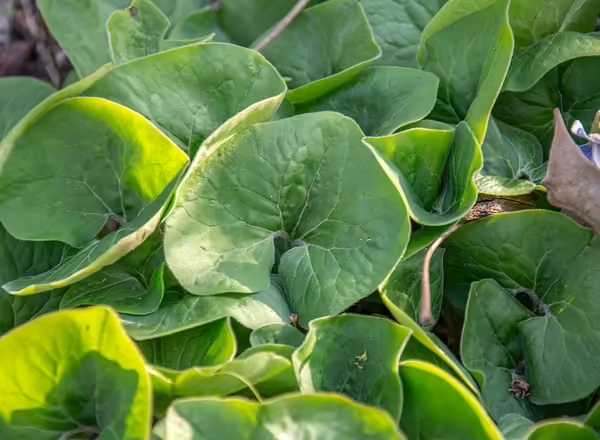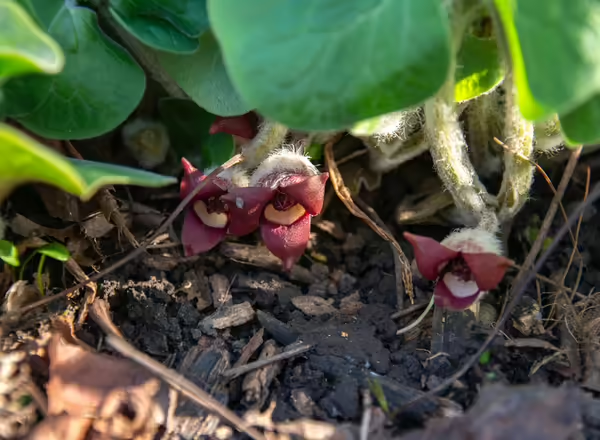
Shaded areas can be difficult areas to landscape, especially when it comes to groundcovers. Turfgrass often struggles, and many commonly used groundcovers, like lily of the valley, wintercreeper, periwinkle, and English ivy, can become problematic because of their aggressive spreading and potential invasiveness. Canadian wild ginger (Asarum canadense) is a perennial plant with attractive foliage and has become an increasingly popular ground cover for shaded areas of landscapes. It is native to the woodlands of eastern North America, including Illinois.
Wild ginger grows to be four to eight inches tall and has attractive, deciduous, heart or kidney-shaped dark green leaves that can reach up to four inches wide. The leaves are often covered in fine hairs. While many people grow plants for their flowers, you’ll likely have to do a little searching to find the flowers of wild ginger. The flowers are small, bell-shaped, and brownish-purple, located at the base of the plant, and are usually hidden beneath the foliage. The plants will bloom in April and May.
Growing Wild Ginger
Wild ginger is hardy in zones 3-8 and prefers shady areas with moist, well-drained soils that are rich in organic matter. Plants will spread via rhizomes and can form a dense ground cover up to twelve inches wide.
Wild ginger is usually planted as transplants in the early spring or fall, as it begins to go dormant. Plants can also be divided; this is best done in the early spring (don’t collect plants from the wild). Wild ginger can also be grown from seed, but it will take time. The seeds should not be allowed to dry out and will need to go through a double dormancy to germinate (warm/moist then cold/moist stratification), so they won’t germinate until the spring after they have been planted at the earliest.



Pollination and Other Wildlife Interactions
For many years, it was believed that wild ginger was pollinated by beetles and flies. It was believed that the flowers attract flies by mimicking decomposing flesh. Since the flowers are close to the ground, flies find them as they emerge from the ground in spring. However, there is little evidence that this happens. Instead, it is now believed that they are almost entirely self-pollinated.
Like many other spring-blooming wildflowers, wild ginger relies on ants to help disperse its seeds. The seeds contain elaiosomes, which are fleshy structures that are full of fats. Ants will collect the seeds and bring them back to their nests to feed on the elaiosomes.
Once the ants have eaten the elaiosome, they will dispose of the seed in an abandoned gallery in their nests or a trash pile close to their nests. Doing so provides the seeds with an area that has lots of nutrients that will aid their growth and helps disperse the seeds away from the parent plant.
If deer or rabbits are a problem in your landscape, you’re in luck. Wild ginger is considered to be deer and rabbit resistant as they find it unpalatable.
Is Wild Ginger the Same as Ginger?
Despite its common name, wild ginger is not related to culinary ginger (Zingiber officinale), commonly used in cooking. In fact, they aren’t even closely related; wild ginger belongs to Aristolochiaceae, or the birthwort family (Dutchman’s pipe, Aristolochia macrophylla, is another member), while culinary ginger is part of the ginger family (Zingiberaceae).
However, the plants do have a ginger-like odor and flavor and were used by Native Americans and European settlers as a spice. The roots were harvested, dried, and then ground into a powder. Roots were also cooked in sugar water to create candied roots, and the leftover liquid was boiled to create a syrup. The plants were also used to treat various ailments.
Unfortunately, wild ginger contains aristolochic acid, which is a carcinogenic compound that can also damage the kidneys. Because of this, the consumption of wild ginger is not recommended.
Good Growing fact of the week: What many people call the petals of wild ginger are actually three fused sepals; the flowers don’t have petals.
References and for more information
Armitage, A M. 2020. Herbaceous Perennial Plants: A Treatise on Their Identification, Culture, and Garden Attributes. Champaign, Illinois: Stipes Publishing, LLC.
“Dr. Duke’s Phytochemical and Ethnobotanical Databases.” n.d. U.S. Department of Agriculture. Accessed April 15, 2025. https://phytochem.nal.usda.gov/.
Hayden, W John. 2010. “Don’t Judge a Book by Its Cover: The Curious Case of Wild Ginger Pollination.” Bulletin of the Virginia Native Plant Society 29 (1): 1. https://scholarship.richmond.edu/cgi/viewcontent.cgi?article=1143&context=biology-faculty-publications
Kelly, Lawrence M. 2009. “Taxonomy of Asarum Section Asarum (Aristolochiaceae).” Systematic Botany 26 (1): 17–53. https://doi.org/10.1043/0363-6445-26.1.17.
Want to get notified when new Good Growing posts are available? SIGN ME UP!
Give us feedback! How helpful was this information (click one): Very helpful | Somewhat helpful | Not very helpful
MEET THE AUTHOR
Ken Johnson is a Horticulture Educator with University of Illinois Extension, serving Calhoun, Cass, Greene, Morgan, and Scott counties since 2013. Ken provides horticulture programming with an emphasis on fruit and vegetable production, pest management, and beneficial insects. Through his programming, he aims to increase backyard food production and foster a greater appreciation of insects.